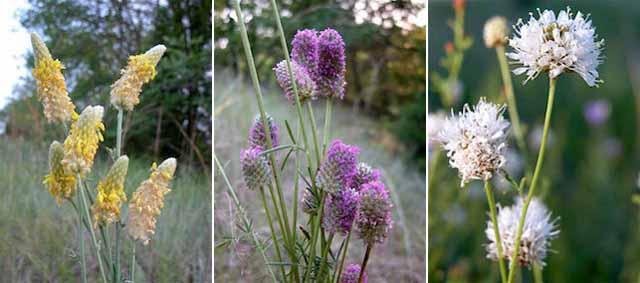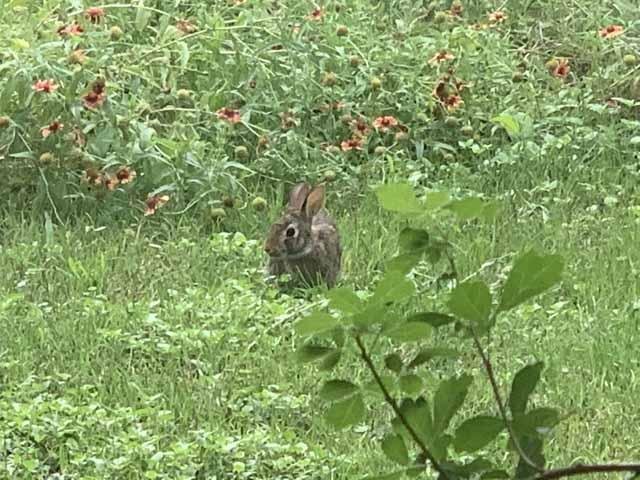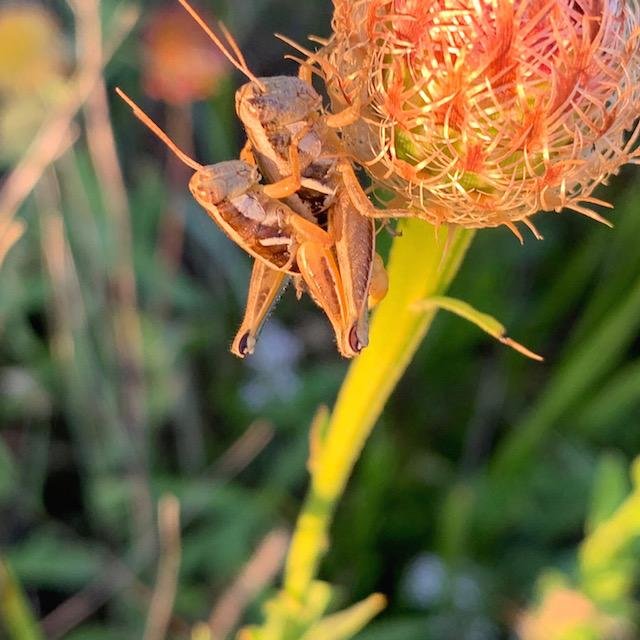Prairie Notes #162 - It's Delightful, It's Delovely, It's Dalea
Prairie Notes are monthly photo/journal observations from Tandy Hills Natural Area by Founder/Director, Don Young. They include field reports, flora and fauna sightings, and more, mixed with a scoop of dry humor and a bit of philosophy.
They are available free to all who get on the FOTHNA email list.
It's Delightful, It's Delovely, It's Dalea
Prairie Notes #162
June 1, 2020
01) It's Delightful, It's Delovely, It's Dalea
02) Field Report - May
03) Kids & Family Nature Fun (Indoors & Out)
04) New Species - May
05) National Prairie Day
06) Volunteer Spotlight
07) PrairieSky / StarParty News
08) Close Encounter of the Greensnake Kind
09) Prairie Proverb - Cole Porter
01) It's Delightful, It's Delovely, It's Dalea
Dalea is one of the loveliest and eye-catching late-spring/early summer prairie wildflowers. Though releatively common, they don't blanket the prairie like say, Greenthread or Purple Paintbrush. Rather, they grow in small clumps here and there, timidly awaiting your discovery of their exotic flowers.
Tandy Hills has 3 main species of Dalea, commonly known as prairie clover: Golden Prairie Clover (Dalea aurea), Roundheaded or White Prairie Clover (Dalea multiflora) and my personal fave, Compact Prairie Clover (Dalea compacta) known perhaps more accurately as, Showy Prairie Clover.
Dalea's are in the pea family and are not true clovers. All are well adapted to limestone prairies and are indicative of a healthy one. I'm told that grazing animals love them, too. The sparse foliage of these plants enable them to better withstand drought and heat. As with all legumes, they add fertility to the soil and provide nectar for insects. The species was named for, Samuel Dale, English botanist and physician, 1659 - 1739.
For the casual prairie saunterer, they are simply a delight to the eye, especially, Dalea compacta with its tutu of purple and orange psychedelic colors circling a central shaft. Showy, is indeed, an accurate description.
DY
02) Field Report - May
Every spring is different at Tandy HIlls. The predicted mega-bloom on the Iconic Prairie didn't quite develop as expected. Too much rain at the wrong time? Perhaps. It's difficult to say. Despite the less than jaw-dropping, mattress-thick, picture-perfect prairie, there was and is much to see including the spring grasses that are filling in the meadows. You just have to look a little closer. Here are a few of my flora and fauna observations during the month of May.
03) Kids & Family Nature Fun (Indoors & Out)
- Explore Space with Virtual Star Parties and Online Space Camp Starting June 8.
Live star parties at Tandy Hills are on hiatus, but the Fort Worth Astronomical Society is offering virtual star parties. Check the FWAS for their next event. https://www.youtube.com/watch?v=yiiH-WdLSjw
Explore the universe this summer using a global network of mountaintop robotic telescopes! Astronomers with Slooh will guide you. They’re offering a quarantine special of just $20 for Space Camp. No prior knowledge is needed for this introduction to astronomy.
Michael Smith's, Treefrog Times, is a nature journal for kids and parents. You will find cool stories and activities for home-bound kids. Recommended. Here's the latest issue and it's absolutely FREE!: https://jsdragons.files.wordpress.com/2020/05/treefrog-times-may2020.pdf
04) New Species - May
Lots of new species were observed in May including, 4 exciting new Dragonflies. Although technically not a new species, a rare example of a yellow Texas Indian Paintbrush was spotted. The new species total as of May 30 is, 1342, an increase of 27. Here's a partial May list with a few favorite photos.
Calico Pennant (Celithemis elisa)
Carnea-group Green Lacewings (Complex Chrysoperla carnea-group)
Carolina Saddlebags Dragonfly (Tramea carolina)
Cherokee Sedge (Carex cherokeensis)
Clover Stem Borer (G. Languria mozardi)
Ebony Bug (G. Corimelaena)
Flea Beetle (Kuschelina petaurista)
Greenbottle Fly (G. Lucilia)
Groundselbush Beetle (Trirhabda bacharidis)
Lantana Lace Bug (Teleonemia scrupulosa)
Lesser Meadow Katydids (G. Conocephalus)
Mud-dauber Wasp (Podium luctuosum)
Oak Leaftier Moth (Acleris semipurpurana)
Seed Bug (Oedancala dorsalis)
Southern Carpenter Bee (Xylocopa micans)
Sulphur-tipped Clubtail (Phanogomphus militaris)
Thrips (Genus Frankliniella)
Twelve-spotted Skimmer Dragonfly (Libellula pulchella)
Visit the Tandy Hill iNaturalsit project page HERE: https://www.inaturalist.org/projects/tandy-hills-natural-area-stratford-...
05) National Prairie Day
NPD, founded by the Missouri Prairie Foundation in 2017 is celebrated on the first Saturday in June. That's June 6th, 2020, a good time to visit one of the remnant prairies in the area and hunt for delightful Dalea's and a multitude of other species! The American prairie is said to evoke our national spirit. That is something we desperately need these days. Come on in!
06) Volunteer Spotlight
A neighbor called me a couple weeks ago telling me he saw a young girl cleaning up trash at Tandy Hills along View Street. Always looking for new recruits to the cause, I ran outside to greet her, thank her and ask a few questions. I was surprised to learn that, Celina Garcia, also lives on View Street and is so young. Her actions during these quarantined times are inspirational and very helpful to keeping Tandy Hills looking good. We need more like her.
Q: How old are you Celina?
A: I am 13 years old
Q: Where do you got to school?
A: I go to J.P. Elder Middle School
Q: Do you have a favorite subject at school?
A: Yes, my favorite subject is science.
Q: How long have you and your family lived on View Street?
A: Since July 2014.
Q: Have you done much exploring at Tandy Hills?
A: Yes, I like examining the flowers and plants of Tandy Hills.
Q: What made you decide to start cleaning up trash at the park?
A: Usually when my mom and I go to the park she takes a bag with her to pick up trash, and since quarantine has made me bored at home doing nothing I thought that one of the best ways of spending that time is making Tandy hills cleaner. Picking up trash is not only great for our park but it also makes me feel better about myself and what I’m doing.
Q: Do you plan to continue your clean-up work at Tandy Hills?
A: Yes, I plan on going on with it especially because with quarantine many people are coming and leaving their trash. I think that if people see that our park is clean, they will try to keep it clean.
Celina Garcia decided to spend some of her quarantied time to help clean up trash dumped at Tandy Hills.
07) PrairieSky / StarParty News
The star parties are still on a pandemic hiatus. Nevertheless, we are hopeful that it will be safer in July. Hang on...See #03 above for a fun alternative.
For home star gazing, FW Astronomical Society rep, Pam Kloepfer, tells us what to look for in June:
"Bright Venus is very low in the sky now and will become a morning planet early in the month; however, you can spot Mercury in the West after sunset the first two weeks of June. Don’t wait too long; it sets quickly! You can also see Castor and Pollux, the Gemini twins, in the twilight. They become further apart as they head West to set. The planets Jupiter and Saturn rise late at night. You can see them set in the southwest before sunrise. Full Moon comes early in the month on June 5th. From then on, the moon rises later and later each night. Begin looking in the southwest for the pale white moon in the morning! You will see it become slimmer and slimmer. New Moon is June 21, where we don’t see it at all, as it is traveling with the Sun. Watch each evening after sunset for a thin crescent to wax again, becoming First Quarter on June 28."
08) Close Encounter of the Greensnake Kind
The westernmost side of Tandy HIlls has always been the wildest side. The hills are steep and creeks often have water. There's a lot of Cedar, Oak and Elm tree cover with open prairie clearings hidden throughout. It's one of the few corners of Tandy Hills where I can still get lost. Few people hike there and no neighborhoods abut it. That's a good thing for the wildlife.
I've seen Hawks consuming their kill over there, feathers and bones covering the ground. I've seen Grey Fox in there a few times, but not lately. I can now add, Rough Greensnake to the list.
May 30th was a beautiful evening. A clear sky carried pleasant temps on a light northeast breeze. I was there looking for a rare, yellow-tinted Texas Paintbrush someone had reported the day before. After a productive hike, I headed happily back to the car, my mind elsewhere. Trudging up a particularly steep slope, my hands full of cameras, I was about to brush back a dry stalk blocking the trail when I caught a glmpse of it.
I admit to being fairly startled, (OK, I shrieked like a girl) but quickly recovered when I recognized what it was. Rough Greensnakes are nonvenomous, docile and a rare treat to find at Tandy Hills. According to iNaturalist, only one other sighting has been reported at Tandy Hills and it was by me in 2005.
Unlike most other, brown-ish colored snakes, their bright, lime green colors with yellow-ish bellies help them stand out. They are only about 3/8" - 1/2" in diameter but grow to about 48" long. They are described as, "highly abroeal", another way of saying they climb through bushes and trees which is where I have seen them both times. Unlike many snakes, they are largely, "diurnal", meaning they are active in the daytime and sleep at night. Their diet is mostly insects. Breeding occurs in the spring with females depositing 2-14 eggs, sometimes in communal nests with other females.
The one I encountered was very docile, allowing me to get close and snap a few pics. I consider myself lucky to have seen this beautiful snake. It's another reminder that Tandy HIlls is about more than just wildflowers. It is a vital wildlife refuge that needs better protection.
09) Prairie Proverb
“The night is young, the skies are clear
So if you want to go walking, dear
It’s delightful, it’s delicious, it’s de-lovely.”
Prairie Notes© is the official newsletter of Friends of Tandy Hills Natural Area, a 501 (c)(3) non-profit organization. All content by Don Young except where otherwise noted.













































